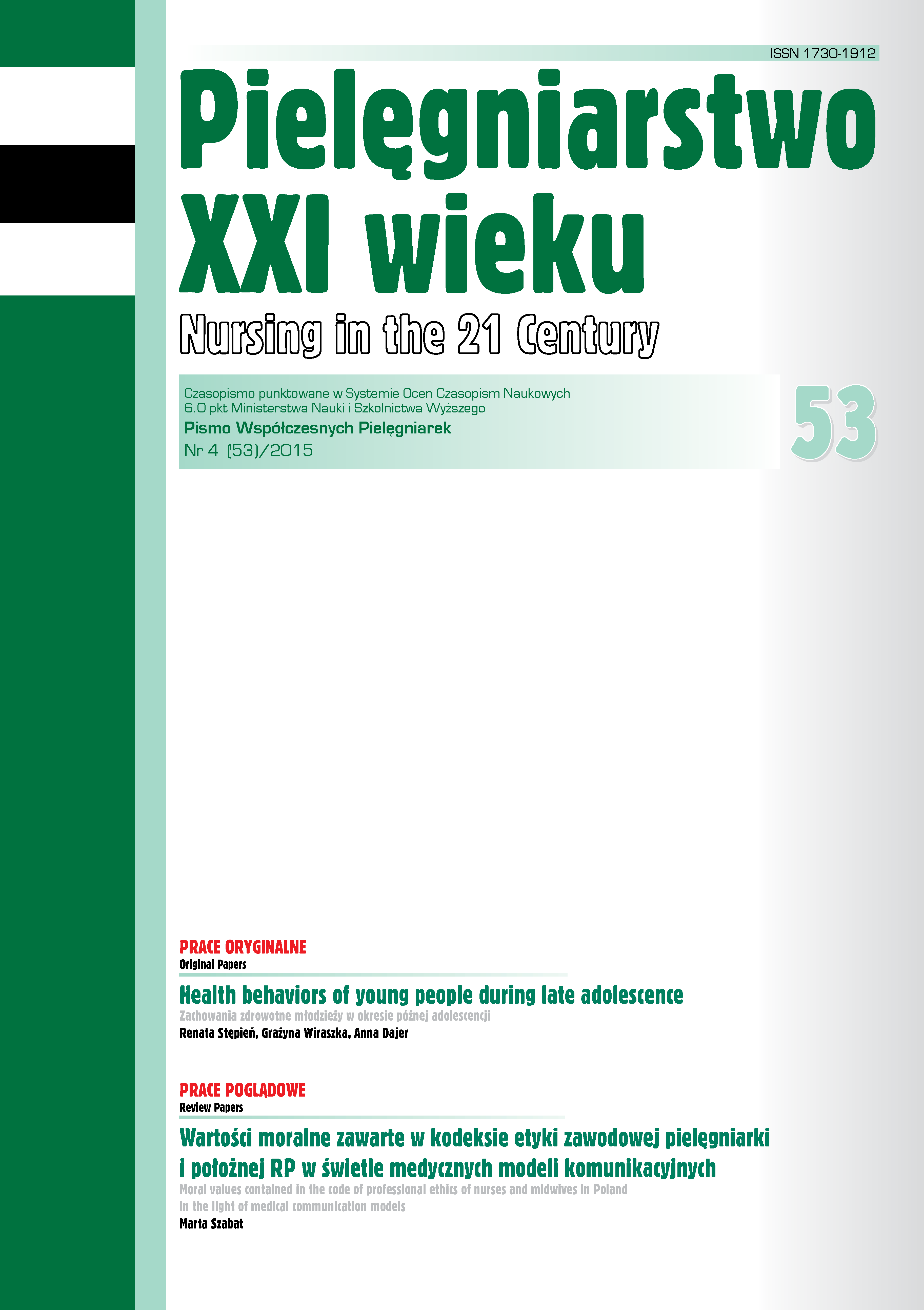A comparative analysis of the progress of e-learning education of nursing students in the field of Reliability in scientific research. E-learning education
DOI:
https://doi.org/10.12923/p21w-2015-4/52Keywords:
nursing education, educational measurement, distance educationAbstract
A COMPARATIVE ANALYSIS OF THE PROGRESS OF E-LEARNING EDUCATION OF NURSING STUDENTS IN THE FIELD OF RELIABILITY IN SCIENTIFIC RESEARCH. E-LEARNING EDUCATION
Aim. A comparative analysis of two methods of organising e-courses designed for students of nursing and conducted throughout 2012/13 and 2013/14 at the Medical University of Warsaw (MUW) within the framework of education in “Reliability in scientific research”.
Material and Methodology. A group of 285 students of the 1st degree course at the Nursing Faculty, including 141 subjects from the academic year 2012/13 and 144 from 2013/14. Data from reliability reports were analysed comparatively as well as the scored results that represented the assessment results for the solved tasks prepared in the form of Short Answer Questions (SAQs) or tests generated automatically (Multiple-Choice Questions, MCQs).
Results. Students who passed the e-course in SAQ format, spent a considerable longer amount of time on the MoodleTM platform (229.1 ± 122.23 minutes, academic year of 2012/13) than the students who passed the e-course taking MCQs (175.3 ± 93.38 minutes, academic year 2013/14) (U Mann-Whitney test = 7298.0, P = 0.0002). Moreover, the activities of students in consecutive months of the academic year 2012/13 were similar to the activities of the academic year 2013/14. Reliability evaluation of the pool of test questions points to a high degree of internal consistency of the exam set (α-Cronbach = 0.93, standard error = 0.12).
Conclusion. Applying an MCQ e-test ensured a reliable evaluation of the students’ progress. The final MCQ type of the test with the set time limit increases the reliability of educational measurement. Regardless of the applied system of organising e-courses, lack of systematic work on part of the students presented the greatest problem throughout the whole term.
References
1. Lewis MJ, Davies R, Jenkins D, et al. A review of evaluative studies of computer-based learning in nursing education. 2001. Nurse. Educ. Today. 2005; 25(8): 586-97; Discussion 98-600.
2. Bloomfield JG, While AE, Roberts JD. Using computer assisted learning for clinical skills education in nursing: integrative review. J. Adv. Nurs. 2008; 63(3): 222-35.
3. Bitzer M. Clinical nursing instruction via the PLATO simulated laboratory. Nurs. Res. 1966; 15(2): 144-150.
4. Glen S. E-learning in nursing education: Lessons learnt? Nurse. Educ. Today. 2005; 25(6): 415-417.
5. Strona Moodle Zakładu Dydaktyki i Efektów Kształcenia Wydziału Nauki o Zdrowiu Warszawskiego Uniwersytetu Medycznego: http://www.nzd.moodle.wum.edu.pl/ [dostęp 29-08-2015].
6. Uribe-Tirado A, Melgar-Estrada L-M, Bornacelly-Castro J-A. Moodle learning management system as a tool for information, documentation, and knowledge management by research groups. Prof. Inform. 2007;16(5): 468-474.
7. Moodle: http://moodle.net/stats/ [dostęp 29-08-2015].
8. Pineda J. Implementation of the virtual platform Moodle in a clinical pharmacology course for medical students. Methods and Findings in Experimental and Clinical Pharmacology. Barcelona: Prous Science; 2008.
9. Garcia Urena MA, Marin Gomez LM, Vega Ruiz V, Diaz Godoy A. Application of new technologies to the teaching of surgery in the school of medicine. Cir. Esp. 2009; 85(3): 165-170.
10. Sparacia G, Cannizzaro F, D’Alessandro DM, et al. Initial experiences in radiology e-learning. Radiographics. 2007; 27(2): 573-581.
11. Ludert T, Nast A, Zielke H, et al. E-learning in the dermatological education at the Charite: evaluation of the last three years. J. Dtsch. Dermatol. Ges. 2008; 6(6):467-472.
12. Gotlib J. Opinie studentów pielęgniarstwa na temat realizacji zajęć dydaktycznych z przedmiotu „Prawo w ochronie zdrowia” w formie kursu e-learningowego. Zdr. Pub. 2012; 122(4): 419-425.
13. Ramos C, Yudko E. “Hits”(not “discussion posts”) predict student success in online courses: a double cross-validation study. Comput. Educ. 2008; 50(4): 1174-1182.
14. Wang AY, Newlin MH. Characteristics of students who enroll and succeed in psychology Web-based classes. J. Educ. Psychol. 2000; 92(1): 137-143.
15. Seluakumaran K, Jusof FF, Ismail R, Husain R. Integrating an open-source course management system (Moodle) into the teaching of a first-year medical physiology course: a case study. Adv. Physiol. Educ. 2011; 35(4): 369-377.
16. Ahern TC, Durrington V. Effects of anonymity and group saliency on participation and interaction in a computer-mediated small-group discussion. J. Res. Comput. Educ. 1995; 28(2): 133-147.
17. Dillon GF, Clyman SG. The computerization of clinical science examinations and its effect on the performances of third-year medical students. Acad. Med. 1992; 67(10 Suppl): S66-S68.
18. Gierl MJ, Lai H, Turner SR. Using automatic item generation to create multiple-choice test items. Med. Educ. 2012; 46(8): 757-765.
19. Kibble J. Use of unsupervised online quizzes as formative assessment in a medical physiology course: effects of incentives on student participation and performance. Adv. Physiol. Educ. 2007; 31(3): 253-260.
20. Ben-David MF. AMEE Guide No. 18: Standard setting in student assessment. Med. Teach. 2000; 22(2): 120-130.
Downloads
Published
Issue
Section
License
Copyright (c) 2015 Mariusz Panczyk, Magdalena Woynarowska-Sołdan, Jarosława Belowska, Aleksander Zarzeka, Joanna Gotlib (Autor)

This work is licensed under a Creative Commons Attribution 4.0 International License.




